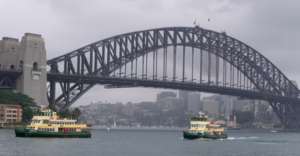
Public transport (also public transportation or public transit) is a shared passenger transportation service which is available for use by the general public. Some common public transport modes are buses, trains, and trams. These are distinct from modes such as bush aircraft, taxicab, car pooling or hired buses which are not shared by members of the public without private arrangement.
Most public transport runs to a scheduled timetable with the most frequent services running to a headway. Share taxi offers on-demand services in many parts of the world and some services will wait until the vehicle is full before it starts. Paratransit is sometimes used in areas of low-demand and for people who need a door-to-door service.[1]
Vehicle types[edit | edit source]
Communal transportation vehicles include: cycle rickshaws, auto rickshaws, subway, train, trolley, bus, monorail, folding city car (for point-to-point "cab"-trips only), skycabs,... tramway, metro, TGV, people mover, funicular, funitel cabin).
Design of appropriate vehicles to best serve the public in a given region is an important component of an attractive, functional system. Some examples of design of modern public transport vehicles in Europe, including several new light rail systems in major cities, is provided at the website of the firm Neerman & Partners managed by Johan Neerman.
Public Transport Planning[edit | edit source]
New research suggests that the key to an effective public transport network, that can provide a high level of service to a city's citizens, is the concept of Integrated Multimodal Network Planning - especially in conjunction with Public Transport Prioritisation.
Also, an approach being explored to better fund improvements to public transport services, esp. in terms of extending light or heavy rail networks, is Land value capture.
Funding Approach[edit | edit source]
Multiple measures exist to fund public transport. Generally, it is based on a mixture of a direct user-pays system in terms of fares for travel, with some government funding from general taxation. There are also examples of using Land value capture to at least partially fund transport network improvements.
Some advocate for "free public transport" to the end-user (implying funding the system in other ways), however there is still an active debate amongst transport professionals and academics as to whether this is a good idea[2] .
Information Systems[edit | edit source]
Information technology has had an important effect on public transport at the system level - both to potentially make the system more user-friendly using Smart phones via services such as dynamic timetable Apps, but also to support improved fleet operations and network planning. See the Transport informatics page for several relevant examples. Development of more widely-shared standards for multi-modal timetable data, such as the General Transit Feed Specification (GTFS), has had a significant impact in this respect.
See also[edit | edit source]
- Public transport informatics
- Transport Informatics
- Sustainable transport
- The OSSTIP project on Appropedia, which aims to develop platforms and workflows to support sustainable transport planning, including more effective use of public transport, using Open source software and Open data resources.
Notes and references[edit | edit source]
External links[edit | edit source]
- Wikipedia:Public transport
- TransitCenter - a New York based research and advocacy NGO who aim to "spark innovations and support policies that improve public transportation for riders, businesses and communities."
- Revolution Rickshaws - "fossil-fuel-free transport solutions" (using human power and solar power) in New York City.
- American Public Transportation Association - Public transport advocacy website, offering excellent arguments for public transportation.
- Bullet point arguments for public transport: press kit.
- Google Transit - Trip itinerary planning. Service is free for transit operators and riders. Ask your local transit operator to get on board (more to come).
See also many of the external links from the Sustainable transport page.